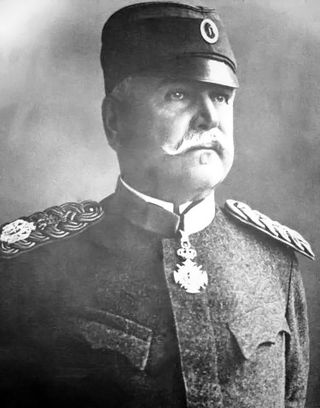
Stepan "Stepa" Stepanović was a Serbian military commander who fought in the Serbo-Turkish War, the Serbo-Bulgarian War, the First Balkan War, the Second Balkan War and World War I. Having joined the Serbian military in 1874, he fought against the forces of the Ottoman Empire in 1876. Over the following years, he climbed up the ranks of the Serbian Army and fought against Bulgarian forces in 1885. He eventually became the Serbian Minister of War in April 1908 and was responsible for instituting changes in the Serbian Army.
The Serbian First Army was a Serbian field army that fought during World War I.
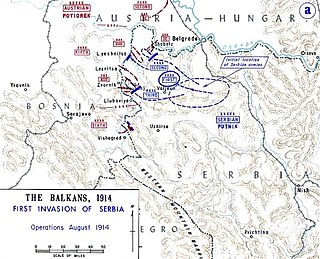
The Battle of Cer was a military campaign fought between Austria-Hungary and Serbia in August 1914, starting three weeks into the Serbian Campaign of 1914, the initial military action of the First World War. It took place around Cer Mountain and several surrounding villages, as well as the town of Šabac. The Battle of Cer is known as the first Allied victory over the Central Powers in the First World War.

The Battle of Kolubara was fought between Austria-Hungary and Serbia in November and December 1914, during the Serbian Campaign of 1914.

The Serbian campaign was a series of military expeditions launched in 1914 and 1915 by the Central Powers against the Kingdom of Serbia during the First World War.
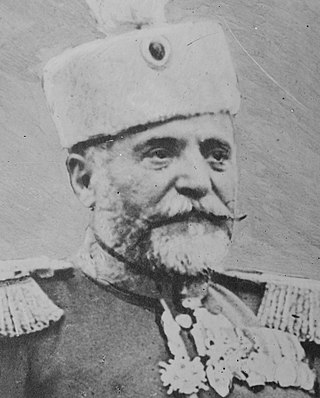
Radomir Putnik was the first Serbian Field Marshal and Chief of the General Staff of the Serbian army in the Balkan Wars and in the First World War. He served in every war in which Serbia fought from 1876 to 1917.

The Belgrade offensive or the Belgrade strategic offensive operation was a military operation during World War II in Yugoslavia in which Belgrade was liberated from the German Wehrmacht through the joint efforts of the Soviet Red Army, Yugoslav Partisans, and the Bulgarian Army. Soviet forces and local militias launched separate but loosely cooperative operations that undermined German control of Belgrade and ultimately forced a retreat. Martial planning was coordinated evenly among command leaders, and the operation was largely enabled through tactical cooperation between Josip Broz Tito and Joseph Stalin that began in September 1944. These martial provisions allowed Bulgarian forces to engage in operations throughout Yugoslav territory, which furthered tactical success while increasing diplomatic friction.
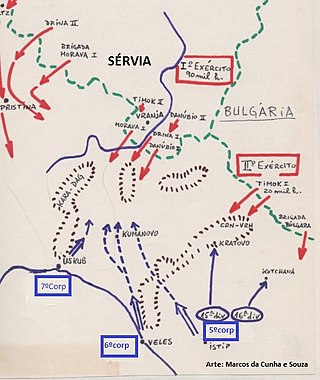
The Battle of Kumanovo, on 23–24 October 1912, was a major battle of the First Balkan War. It was an important Serbian victory over the Ottoman army in the Kosovo Vilayet, shortly after the outbreak of the war. After this defeat, the Ottoman army abandoned the major part of the region, suffering heavy losses in manpower and in war materiel.

The Battle of the Drina was fought between Serbian and Austro-Hungarian armies in September 1914, near Loznica, Serbia, during the First Serbian campaign of World War I.

The Battle of Krivolak was a World War I battle, fought between 21 October and 22 November 1915. It was fought in the initial stage of the Macedonian campaign, in the Balkans Theatre. On 21 October, Bulgarian troops attacked the French-held positions near the Strumica rail station, at the time part of the Kingdom of Serbia, starting the battle. Fighting continued until 22 November, when two Serbian divisions failed to capture Skopje, thus rendering the continuation of Entente offensive operations dangerous and forcing the French to evacuate their forces from the region.

The Great Retreat, also known in Serbian historiography as the Albanian Golgotha, was a strategic withdrawal of the Royal Serbian Army, which marked the end of the Second Serbian campaign of World War I.
The 1st Army Group was a Royal Yugoslav Army formation mobilised prior to the German-led Axis invasion of Yugoslavia in April 1941 during World War II. It consisted of the 4th Army, 7th Army, and the 1st Cavalry Division, which was the army group reserve. It was responsible for the defence of northwestern Yugoslavia, with the 4th Army defending the eastern sector along the Yugoslav–Hungarian border, and the 7th Army defending the western sector along the borders with Germany and Italy. Like all Yugoslav formations at the time, the 1st Army Group had serious deficiencies in both mobility and firepower as well as internal friction among the different ethnic groups, particularly between Serbs and Croats.

The 4th Army was a Royal Yugoslav Army formation mobilised prior to the German-led Axis invasion of the Kingdom of Yugoslavia during World War II. It was drawn from the peacetime 4th Army District. When mobilised, it consisted of three divisions, a brigade-strength detachment, one horse cavalry regiment and one independent infantry regiment. It formed part of the 1st Army Group, and was responsible for defending a large section of the Yugoslav–Hungarian border, being deployed behind the Drava river between Varaždin and Slatina. Like all Yugoslav formations at the time, the 4th Army had serious deficiencies in both mobility and firepower.
Operation Una was a military offensive conducted by the Croatian Army against the Army of Republika Srpska in western Bosnia and Herzegovina on 18–19 September 1995, during the Bosnian War. The operation entailed a crossing of the Una and Sava rivers to establish bridgeheads at Novi Grad, Bosanska Dubica, Bosanska Kostajnica and opposite Jasenovac to allow for a subsequent advance towards Prijedor and Banja Luka.

The Battle of Kosturino was a World War I battle fought between 6 and 12 December 1915. It was fought in the initial stage of the Macedonian campaign, in the Balkans Theatre. On 6 December, Bulgarian troops attacked the French and British-held trenches in Kosturino, at the time part of the Kingdom of Serbia. Though the early offensive was held in check, on 8 December, Bulgaria managed to infiltrate the Memesli ravine. Bulgaria then seized Crete Simonet, thus threatening to outflank the Allies. The Entente defeat at Kosturino led to the complete withdrawal of Allied forces from Serbia, thus enabling the Central Powers to build the Berlin to Constantinople rail line. In the meantime, the Allies concentrated on solidifying their defenses in Greece.
The 27th Infantry Division Savska was an infantry formation of the Royal Yugoslav Army that formed part of the 4th Army during the German-led invasion of Yugoslavia by the Axis powers in April 1941. It was raised from the Savska divisional district, and like all Yugoslav infantry divisions of the time, was a very large and unwieldy formation almost entirely reliant on animal transport for mobility. Commanded by Divizijski đeneral August Marić, the division was largely made up of ethnic Croat troops, many of whom saw the Germans as potential liberators from Serbian oppression during the interwar period. It also lacked modern arms and sufficient ammunition.

The Serbian campaign of 1915 refers to a military campaign carried out by the Central Powers, primarily Germany, Austria-Hungary and Bulgaria, against the Kingdom of Serbia during World War I. The campaign took place from October to November 1915.
The Serbian Campaign of 1914 was a significant military operation during World War I. It marked the first major confrontation between the Central Powers, primarily Austro-Hungary, and the Allied Powers, led by the Kingdom of Serbia. The campaign started on 28 July 1914, when Austria-Hungary declared war on Serbia and bombarded Belgrade. On 12 August, the Austro-Hungarian forces led by General Oskar Potiorek, launched their first offensive into Serbia.
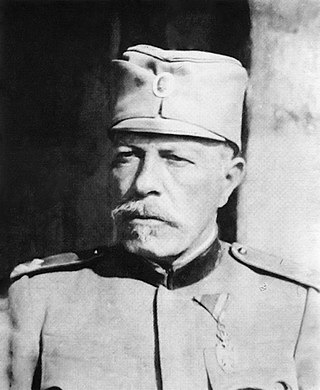
Vladimir Kondić was a 20th-century Serbian general. He is notable for his participation in the Serbo-Bulgarian War, First Balkan War, Second Balkan War and the First World War.
Ivan S. Pavlović was a highly distinguished Serbian officer of the Serbian Army in World War I. He was the commander of the Army of the West, centered in Užice. After the war he was divisional general of Yugoslav army.













